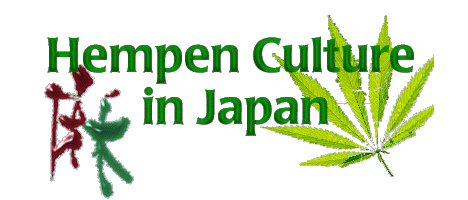|
Bibliography
Asakoji. Asakoji store. Kyoto, Japan. Translated by Misa Nakanishi. 1997.
Atomic Bomb Museum. Personal visit to the Atomic Bomb Museum in Hiroshima, Japan.1994.
Berry. Hideyoshi. Mary Elizabeth Berry, The Council for East Asian Studies, Harvard University Press.1982.
Bennet. Conversation with Chris Bennet of Tofino, B.C. 1997.
Constantine. Japanese Street Slang by Peter Constantine, Tengu Books,
Tokyo, Japan. 1992.
De Mente. Everything Japanese. Boye De Mente, Passport Books, Chicago, IL. 1987.
Dewey. USDA Bureau of Plant industry, Report of the Chief: No. 26 by Lyster H. Dewey. 1920.
from: http://pressenter.pressenter.com/~davewest/fiberwars/chp5fr.html
Dodge. A Report on the culture of hemp and jute in the United States,. USDA Office of Fiber Investigations Report No. 8:7. 1896.
from: http://pressenter.pressenter.com/~davewest/fiberwars/chp5fr.html
Drake. Bill Drake. "The Cultivator's Handbook". Wingbow Press, Berkely,
CA. 1970.
Funakoshi. “What is Karate?” from Karate-do Kyohan by Master Ginchin Funakoshi. Kodanasha International. Thanks to JW.
http://buho.dpi.udec.cl/Shotokai-Budo/ingles/kyohan/karakyoh.html
Fukuzawa. Autobiography of Yukichi Fukuzawa, Translated by Eiichi Kiyooka, Columbia Univ. Press, NY, NY.1960. pgs. 112-113.
Gruett. Personal Conversations with Steve Gruett of Gonda, Nagano, Japan
(population 3). 1994.
Hidden Variable. Arcata, CA "Japanese History, Exploring Japanese
Fuedalism." 1997.
http://www.holdit.com/hidden/japan/toc.html
Hooker. Bruce Hooker, Washington State University. "World Cultures:
Ancient Japan, Jomon & Yoyoi," 1996.
http://www.wsu.edu:8000/~dee/AncientJapan/AncientJapanYayoi.html
Hughes. Washi, The World of Japanese Paper, pgs.40, 43,49, 51, 77, 107, 165, 171, 183. Sukey Hughes, Kodansha International Tokyo, New York and San Francisco.1978.
Inoue, Kondo, Hiro. Gakujin Inoue, Poli Kondo, Hiro.
Japanese farmers and artists in the Shinshu area with whom I learned and lived the old ways of Japan. Autumn 1994.
JNTO. Japan National Tourism Organization, On-Line tour guide. 1996.
http://www.jnto.go.jp/05regional/tokushima/experience.html
JW. Personal Correspondence with Joe Wein of Kanto region, Japan.
Joe Wein has a collection of articles and resources about Hemp in Japan and Germany on the WWW.
http://www2.gol.com/users/joewein/hempjpn.htm
Kolander. Personal conversations with master dyer Cheryl Kolander.
Portland, Oregon. "Hemp for Textile Artists" 1996.
Kojien. (encyclopedia), Tokyo, Japan. 4th edition. 1991. Quoted after
JW.
Kojiki. The native creation chronicle of Japan. Quoted from "Religions
of Japan."
KTO. Kansai Time-Out (English Language Weekly), Kobe, Japan. June 1995.
Article: "The Grass is Greener," Sim Andrulli. Article includes
interview with Maeda Koichi. Thanks to Dominic Al-Badri.
http://www.kto.co.jp/kto.html
Lazarus. Japan Times, August 7, 1994.
Article by David Lazarus."Sumertime and the Pot Farming's Easy."
quoted after: http://www2.gol.com/users/joewein/hempjpn.htm
Marui. Personal conversation and correspondance with Hidehiro Marui, lawyer from Shizuoka-ken, Japan in Vancouver 1997. Also from Marui’s book "What is the Ganja" & "Asa and Human Culture.”
thanks to Asada Yutaka.
http://www.asahi-net.or.jp/~IS2H-MRI/
Masuda. Personal conversation with Eiji Masuda, Tokyo, Japan. 1996.
Mayuzumi. Personal correspondence with historian H. Mayuzumi, Tokyo,
Japan. 1996. http://www.ict.co.jp
Mead. Mead Corporation, Dayton Ohio. "History of Paper," 1996.
http://www.mead.com/mead/history.html
Monk. A lecture by a Buddhist priest at The Evergreen State
College, Cultural Transformation in Modern Japan program. Fall 1996.
Moore. Religions of Japan by George Foot Moore. 1913. quoted after: http://www.calyx.net/~schaffer/hemp/hemprefs.html
Rathburn. “Beyond the Tanabata Bridge, Traditional Japanese Textiles,” ed. by Wm. Jay Rathburn. Seattle Art Museum, 1993.
Robinson. The Great Book of Hemp. Rowan Robinson, Park Street Press, Vermont. 1996.
Seattle Asian Arts. Seattle Asian Arts Museum, exhibit on Japanese
Textiles, 1996.
Shizuoka Police. “What is Marijuana?” Shizuoka Police Department Headquaters Public Relations Section. 1995. Thanks to JW.
Smith. The Agrarian Origins of Modern Japan. Thomas C. Smith. Stanford University Press, Stanford, CA. 1959. pgs.77, 79.
Stearns. Peter N. Stearns, Michael Adas, Stuart B. Schwartz. 1992.
"World Civilizations: The Postclassical Era. Chapter 19: Spread Of
Chinese Civilization - Korea, Japan, And Vietnam, The Era Of Warrior
Dominance"
Quoted after http://www.calyx.net/~schaffer/hemp/hemprefs.html
Taki. A Handbook on the Art of Washi: A Collection of Questions and Answers.
by the All Japan Handmade Washi Association. Mr. Chosuke Taki, chariman.
quoted after Joseph Wu,
http://www.datt.co.jp/origami/Info/washi.html
Tomoaki. Personal correspondence with Tomoaki Francisco Kimura, Kyoto,
Japan. "(How to make an) Asa Noren examples by artist Kyoshi Kotaru."
http://www.kyoto-inet.or.jp/people/franz/noren2.html
Yamada. Tokyo Observer magazine #15, "An Interview with Yamada Kaiya".
This interview originally appeared in the December 1995 issue of “Jiyu Ishi.” http://www.twics.com/~anzu/15-Hemp.html
Yasuko. Yasuko Takeuchi is a Japanese quilter in Osaka, Japan.
http://www.mimuclub.com/yasuko
Young. “Japan Hemp Growing Between the Cracks.” Rueters. Stuart Young, Aug. 27, 1997. Quoted after http://www.hempseed.com
Special Domo Arigato to: John Roulac, Joe Wein, Dave West, Rob Clarke,
Sonia Nord, Lauralee Elliott, Charles Tomala, Eiji Masuda, Gyr Walker, David Moore and Misa Nakanishi.
|

